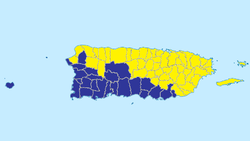
Back حملة بورتوريكو Arabic Εκστρατεία του Πουέρτο Ρίκο Greek Guerra hispano-estadounidense en Puerto Rico Spanish Bitwa pod Coamo Polish په پورټوریکو برید Pashto/Pushto Campanha de Porto Rico Portuguese
| Puerto Rico campaign | |||||||||
|---|---|---|---|---|---|---|---|---|---|
| Part of the Spanish–American War | |||||||||
 Map of the Puerto Rico campaign illustrating operations July 25 – August 12, 1898, and showing municipality borders in 1898. Blue are US Naval forces, red are US land forces, and green are Spanish ground forces.  Map of Puerto Rico under the US and Spanish flags from August 14 til September 19, 1898. The 23 blue-colored municipalities were under the US flag and the 55 yellow-colored municipalities were under the Spanish flag | |||||||||
| |||||||||
| Belligerents | |||||||||
|
| |||||||||
| Commanders and leaders | |||||||||
|
|
| ||||||||
| Strength | |||||||||
| 15,472[2] |
Spain: 8,000 Puerto Rico: 10,000[2] | ||||||||
| Casualties and losses | |||||||||
|
3 killed[3] 40 wounded[3] (mostly by Puerto Rican irregular troops)[3] |
17 killed[3] 88 wounded[3] 324 captured[3] 10,000 surrendered at the end of the campaign[2] | ||||||||
The Puerto Rico campaign was the American military sea and land operation on the island of Puerto Rico during the Spanish–American War. The offensive began on May 12, 1898, when the United States Navy attacked the capital, San Juan. Though the damage inflicted on the city was minimal, the Americans were able to establish a blockade in the city's harbor, San Juan Bay. On June 22, the cruiser Isabel II and the destroyer Terror delivered a Spanish counterattack, but were unable to break the blockade and Terror was damaged.
The land offensive began on July 25, when 1,300 infantry soldiers led by Major General Nelson A. Miles disembarked off the coast of Guánica. After controlling the first skirmish, the Americans advanced to Coamo, where they engaged Puerto Rican and Spanish troops in battle. The battle concluded when the allied soldiers retreated after the battle left two dead on their side, and four on the American side. The United States was able to seize control of Fajardo on August 1, but was forced to withdraw on August 5 after a group of 200 Puerto Rican–Spanish soldiers led by Pedro del Pino gained control of the city, while most civilian inhabitants fled to a nearby lighthouse. The Americans encountered larger opposition as they advanced towards the main island's interior. They engaged in two crossfires in Guamani River and Coamo, both of which were inconclusive as the allied soldiers retreated. A battle in San Germán concluded in a similar fashion with the Spanish retreating to Lares.
On August 9, 1898, American troops that were pursuing units retreating from Coamo and Asomante encountered heavy resistance in Aibonito and retreated after six of their soldiers were injured. They returned three days later, reinforced with artillery units and attempted a surprise attack. After about an hour of fighting, Spanish artillery batteries had been silenced. American guns advanced some 2,150 yards and set up positions, but soldiers reported seeing Spanish reinforcements nearby and the guns were withdrawn back to the main line. Shortly before the launch of a flanking movement on the Spanish, all military actions in Puerto Rico were suspended on August 13, after U.S. President William McKinley and French ambassador Jules Cambon, acting on behalf of the Spanish government, signed an armistice whereby Spain relinquished its sovereignty over the territories of Puerto Rico, Cuba, the Philippines and Guam.
- ^ Zwick, Jim (April 23, 1995). "Sitting in Darkness: An Unheeded Message About U.S. Militarism". Baltimore Sun. pp. J1, J6.
- ^ a b c Negroni, Héctor Andrés (1992). La Guerra Hispanoamericana en Puerto Rico (Military history of Puerto Rico). 1898 Los Documentos de Puerto Rico (in Spanish). Sociedad Estatal Quinto Centenario. ISBN 84-7844-138-7. Archived from the original on January 30, 2012. Retrieved September 4, 2008.
- ^ a b c d e f Malavet, Pedro (2004). America's Colony: The Political and Cultural Conflict Between the United States and Puerto Rico. NYU Press. p. 36. ISBN 9780814756805.